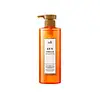What's inside
What's inside
 Key Ingredients
Key Ingredients

 Benefits
Benefits

 Concerns
Concerns

 Ingredients Side-by-side
Ingredients Side-by-side

Water
Skin ConditioningSodium C14-16 Olefin Sulfonate
CleansingCocamidopropyl Betaine
CleansingGlycerin
HumectantPyrus Malus Fruit Extract
Skin ConditioningVinegar
Decyl Glucoside
CleansingVitis Vinifera Fruit Extract
Skin ConditioningRoyal Jelly Extract
Skin ConditioningPersea Gratissima Fruit Extract
EmollientHippophae Rhamnoides Fruit Extract
Skin ConditioningSaccharum Officinarum Extract
MoisturisingMelaleuca Alternifolia Leaf Extract
PerfumingOlea Europaea Fruit Extract
BleachingDaucus Carota Sativa Root Extract
Skin ConditioningPrunus Mume Fruit Extract
HumectantRubus Chamaemorus Fruit Extract
AntioxidantHibiscus Sabdariffa Flower Extract
Skin ConditioningLuffa Cylindrica Fruit Extract
Skin ConditioningActinidia Chinensis Fruit Extract
EmollientCitrus Limon Fruit Extract
MaskingAdansonia Digitata Seed Extract
Skin Conditioning1,2-Hexanediol
Skin ConditioningCaprylhydroxamic Acid
Ethylhexylglycerin
Skin ConditioningMethylpropanediol
SolventSodium Chloride
MaskingPolyquaternium-10
Allantoin
Skin ConditioningGuar Hydroxypropyltrimonium Chloride
Skin ConditioningDisodium EDTA
Cocamide Mea
EmulsifyingCynanchum Atratum Extract
Skin ConditioningCitric Acid
BufferingParfum
MaskingWater, Sodium C14-16 Olefin Sulfonate, Cocamidopropyl Betaine, Glycerin, Pyrus Malus Fruit Extract, Vinegar, Decyl Glucoside, Vitis Vinifera Fruit Extract, Royal Jelly Extract, Persea Gratissima Fruit Extract, Hippophae Rhamnoides Fruit Extract, Saccharum Officinarum Extract, Melaleuca Alternifolia Leaf Extract, Olea Europaea Fruit Extract, Daucus Carota Sativa Root Extract, Prunus Mume Fruit Extract, Rubus Chamaemorus Fruit Extract, Hibiscus Sabdariffa Flower Extract, Luffa Cylindrica Fruit Extract, Actinidia Chinensis Fruit Extract, Citrus Limon Fruit Extract, Adansonia Digitata Seed Extract, 1,2-Hexanediol, Caprylhydroxamic Acid, Ethylhexylglycerin, Methylpropanediol, Sodium Chloride, Polyquaternium-10, Allantoin, Guar Hydroxypropyltrimonium Chloride, Disodium EDTA, Cocamide Mea, Cynanchum Atratum Extract, Citric Acid, Parfum
Water
Skin ConditioningLauryl Glucoside
CleansingCocamidopropyl Betaine
CleansingDisodium Laureth Sulfosuccinate
CleansingTea-Cocoyl Glutamate
CleansingSodium Chloride
MaskingCitric Acid
BufferingHydroxyacetophenone
AntioxidantPolyquaternium-7
Polyquaternium-10
Melaleuca Alternifolia Leaf Oil
AntioxidantOlea Europaea Fruit Oil
MaskingPinus Pinaster Leaf Extract
Skin ConditioningGold
Cosmetic ColorantSalvia Officinalis Leaf Extract
CleansingGlycine Max Callus Culture
AntioxidantLimonene
PerfumingButylene Glycol
HumectantSodium Benzoate
MaskingCitrus Limon Peel Oil
MaskingLavandula Angustifolia Oil
MaskingEchium Lycopsis Fruit Oil
Skin ProtectingEucalyptus Dives Leaf Oil
PerfumingWater, Lauryl Glucoside, Cocamidopropyl Betaine, Disodium Laureth Sulfosuccinate, Tea-Cocoyl Glutamate, Sodium Chloride, Citric Acid, Hydroxyacetophenone, Polyquaternium-7, Polyquaternium-10, Melaleuca Alternifolia Leaf Oil, Olea Europaea Fruit Oil, Pinus Pinaster Leaf Extract, Gold, Salvia Officinalis Leaf Extract, Glycine Max Callus Culture, Limonene, Butylene Glycol, Sodium Benzoate, Citrus Limon Peel Oil, Lavandula Angustifolia Oil, Echium Lycopsis Fruit Oil, Eucalyptus Dives Leaf Oil
Ingredients Explained
These ingredients are found in both products.
Ingredients higher up in an ingredient list are typically present in a larger amount.
Citric Acid is an alpha hydroxy acid (AHA) naturally found in citrus fruits like oranges, lemons, and limes.
Like other AHAs, citric acid can exfoliate skin by breaking down the bonds that hold dead skin cells together. This helps reveal smoother and brighter skin underneath.
However, this exfoliating effect only happens at high concentrations (20%) which can be hard to find in cosmetic products.
Due to this, citric acid is usually included in small amounts as a pH adjuster. This helps keep products slightly more acidic and compatible with skin's natural pH.
In skincare formulas, citric acid can:
While it can provide some skin benefits, research shows lactic acid and glycolic acid are generally more effective and less irritating exfoliants.
Most citric acid used in skincare today is made by fermenting sugars (usually from molasses). This synthetic version is identical to the natural citrus form but easier to stabilize and use in formulations.
Read more about some other popular AHA's here:
Learn more about Citric AcidCocamidopropyl Betaine is a fatty acid created by mixing similar compounds in coconut oil and dimethylaminopropylamine, a compound with two amino groups.
This ingredient is a surfactant and cleanser. It helps gather the dirt, pollutants, and other impurities in your skin to be washed away. It also helps thicken a product and make the texture more creamy.
Being created from coconut oil means Cocamidopropyl Betaine is hydrating for the skin.
While Cocamidopropyl Betaine was believed to be an allergen, a study from 2012 disproved this. It found two compounds in unpure Cocamidopropyl Betaine to be the irritants: aminoamide and 3-dimethylaminopropylamine. High-grade and pure Cocamidopropyl Betaine did not induce allergic reactions during this study.
Learn more about Cocamidopropyl BetainePolyquaternium-10 is an ammonium salt of hydroxyethylcellulose. It is a white and granular powder used as a film-former and anti-static agent.
This ingredient is commonly found in hair conditioning products. According to a manufacturer, its positive charge makes it great for absorbing hair proteins. The manufacturer also states this ingredient helps with curl retention.
For haircare friends: this ingredient is not a silicone.
Learn more about Polyquaternium-10Chances are, you eat sodium chloride every day. Sodium Chloride is also known as table salt.
This ingredient has many purposes in skincare: thickener, emulsifier, and exfoliator.
You'll most likely find this ingredient in cleansers where it is used to create a gel-like texture. As an emulsifier, it also prevents ingredients from separating.
There is much debate on whether this ingredient is comedogenic. The short answer - comedogenic ratings don't tell the whole story. Learn more about comegodenic ratings here.
The concensus about this ingredient causing acne seems to be divided. Research is needed to understand if this ingredient does cause acne.
Scrubs may use salt as the primary exfoliating ingredient.
Learn more about Sodium ChlorideWater. It's the most common cosmetic ingredient of all. You'll usually see it at the top of ingredient lists, meaning that it makes up the largest part of the product.
So why is it so popular? Water most often acts as a solvent - this means that it helps dissolve other ingredients into the formulation.
You'll also recognize water as that liquid we all need to stay alive. If you see this, drink a glass of water. Stay hydrated!
Learn more about Water